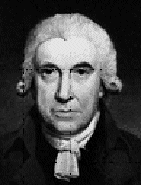
|
|

As early as 1759, his attention had turned to steam as a force for movement. In 1763 he was asked by John Anderson to repair a working model of the newcomen steam engine. He easily fixed it, and seeing its faults, hit upon expedient of the separate condenser. He also improved the air-pump, steam jacket for cylinder, double acting engine and c. he entered a partnership with Mathew Boulton of Soho Engineering works. Watts soon superseded Newcomens machine as a pumping-engine and between 1781 and 1785 he obtained patents for the sun and the plant motion, the expansion principle, the double engine, the parallel motion, a smokeless furnace, and the governor. He described a steam locomotive in one of his patents (1784). He also invented a letter copying press, a machine for copying sculpture and c. The Watt, press, a machine for copying sculpture and c. The Watt, a unit of power , was named after him. A.H. + R.T.G. |
 James
Watt
was born in Greenock. Scotland on the 19th of
January 1736, born as the son of a merchant and town councillors. He
went to Glasgow in 1754 to learn the trade of a mathematical-instrument
maker, and after a year in London, he set up his business in Glasgow.
The hammermens' guild caused trouble for him but Glasgow University
made him its mathematical instrument maker, (1757-1763). He was employed
on surveys for the Forth, the Clyde and the Caledonian canals (1767),
also in the improvement of the harbours Ayr, Port Glasgow and Greenock,
and in the deepening of the both the Forth and Clyde canals and other
rivers.
James
Watt
was born in Greenock. Scotland on the 19th of
January 1736, born as the son of a merchant and town councillors. He
went to Glasgow in 1754 to learn the trade of a mathematical-instrument
maker, and after a year in London, he set up his business in Glasgow.
The hammermens' guild caused trouble for him but Glasgow University
made him its mathematical instrument maker, (1757-1763). He was employed
on surveys for the Forth, the Clyde and the Caledonian canals (1767),
also in the improvement of the harbours Ayr, Port Glasgow and Greenock,
and in the deepening of the both the Forth and Clyde canals and other
rivers.